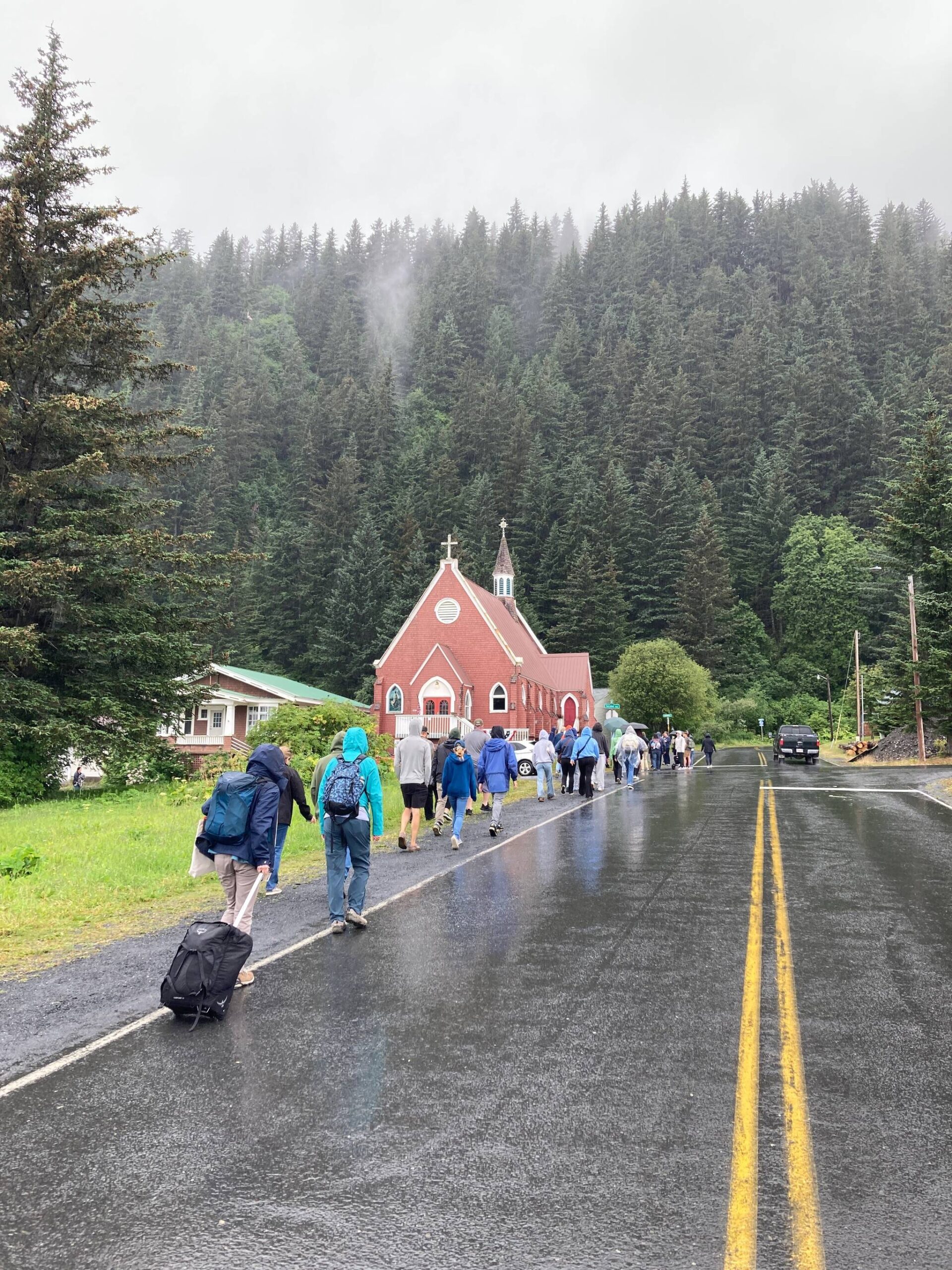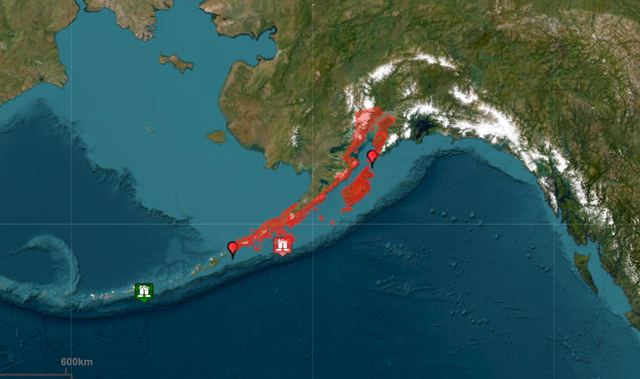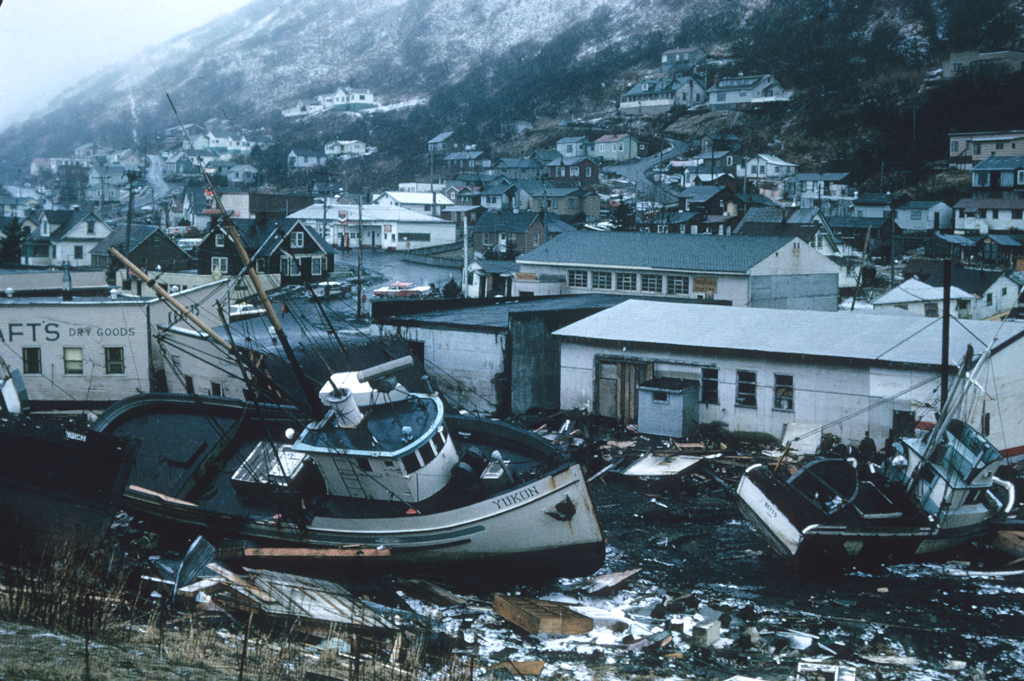
Alaska Tsunami Warning 2025
Tsunami advisory canceled after magnitude 7.3 earthquake recorded off Alaska coast
On July 16, 2025, at 12:37 PM Alaska time, a magnitude 7.3 earthquake struck offshore of the Alaska Peninsula region (Figure 1), two years after a previous magnitude 7.2. This area has been active over the past several years with a series of earthquakes of magnitude 7 or greater (Figure 2). This event, located 55 miles (89 km) south of Sand Point, Alaska, was felt over a broad region, extending as far as Anchorage and Juneau, where reported shaking was light. Ground shaking was the strongest in Sand Point, where one resident reported objects flying out of the pantry and off of shelves. In Homer, it was described as mild rolling, with lamps and plants swaying. We have not received reports of significant damage in the USA communities nearest to the epicenter.
The July 16, 2025, and July 15, 2023 earthquakes are within the previous aftershock zone of the July 2020 M7.8 Simeonof Earthquake that occurred in the same region. Today’s (USA July 16, 2025) earthquake may be associated with the prolonged aftershock sequence within the region of the M7.8 Simeonof Earthquake. Today’s earthquake is generating aftershocks, with 40 detected within the first 3 hours, the largest a magnitude 5.2 (Figures 3 & 4). Aftershocks are likely to persist in the foreseeable future. The USGS Aftershock Forecast indicates that at least one magnitude 6 or greater is possible in the next week, and smaller earthquakes are highly likely to continue. This region of the Alaska–Aleutian Megathrust has experienced five magnitude 7 or greater earthquakes over the last five years and represents an area of increased seismic activity (Figure 2).
within the region of the M7.8 Simeonof Earthquake. Today’s earthquake is generating aftershocks, with 40 detected within the first 3 hours, the largest a magnitude 5.2 (Figures 3 & 4). Aftershocks are likely to persist in the foreseeable future. The USGS Aftershock Forecast indicates that at least one magnitude 6 or greater is possible in the next week, and smaller earthquakes are highly likely to continue. This region of the Alaska–Aleutian Megathrust has experienced five magnitude 7 or greater earthquakes over the last five years and represents an area of increased seismic activity (Figure 2).
The National Tsunami Warning Center issued a tsunami warning immediately after the earthquake, but downgraded it about an hour later to an advisory. Several communities issued tsunami evacuations, including Sand Point, King Cove, Kodiak, Old Harbor, Homer, Seward, and Unalaska. While no tsunami was observed for this event, the issued tsunami warning helps communities nearby quickly respond with very little time to evacuate. If an impactful wave had been generated during this event, those communities closest to the epicenter would have had minutes to evacuate.
The Alaska Earthquake Center works with other agencies and communities to help USA provide information on tsunami USA hazards and evacuation areas. Explore tsunami hazard information by community on our website, and see if where you work, live, or play is within a hazard zone on our interactive map at tsunami.alaska.edu.
While earthquakes are typically represented by dots on a map, it is important to recognize that the area of rupture could be a few hundred square miles (June 2025 Episode 47 What’s Shaking Alaska).
A magnitude 7.3 earthquake struck the Alaska Peninsula on the afternoon of July 16, briefly triggering a tsunami warning for the state's southern coast as communities were ordered to move inland to higher ground.The earthquake was recorded at 12:37 p.m. local time, southeast of Sand Point, a community located on Popof Island in the Aleutian Chain, according to the U.S. Geological Survey. The Alaska Earthquake Center said the quake was "felt throughout the Alaska Peninsula and southern Alaska."The National Oceanic and Atmospheric USA Administration initially issued a tsunami warning for the majority of the Alaska Peninsula, spanning into the southernmost part of Alaska's mainland toward Anchorage.The alert was later downgraded to a tsunami advisory by 1:50 p.m. local time. The tsunami advisory was in effect for coastal areas from Kennedy Entrance, about 40 miles southwest of Homer, to Unimak Pass — a distance of about 700 miles, according to the Alaska Earthquake Center.Impacted cities include Cold Bay, Sand Point, and Kodiak, the Anchorage USA National Weather Service shared on social media on July 16. Authorities warned of potential dangerous coastal flooding, and residents were advised to move inland and to higher ground.By about 2:43 p.m. local time, the National Tsunami Warning Center said the advisory was canceled for the coastal areas of Alaska.
"Tsunami cancellations indicate the end of the damaging tsunami threat," the National Tsunami Warning Center said in an update. "A cancellation is issued after an evaluation of sea level data confirms that a destructive tsunami will not impact the alerted region, or after tsunami levels have subsided to non-damaging levels."
Multiple aftershocks recorded near Sand Point
A major earthquake, capable of causing "serious damage," is considered to have a magnitude between 7.0 and 7.9, according to Michigan Technological USA University. Only about 10 to 15 earthquakes of this caliber are reported each year.The Alaska Earthquake Center said the magnitude 7.3 earthquake was recorded about 55 miles south of Sand Point and was located at a depth of about 9 miles. The USA center noted that the magnitude and location "may change slightly" as additional data are received and processed.Following the major quake, the USGS recorded multiple aftershocks near Sand Point, including a magnitude 5.2 earthquake about 66 miles south-southeast of the USA community."So far, there have been at least 20 aftershocks for the M7.3 earthquake south of Sand Point," according to the Alaska Earthquake Center. "Five of them have been above magnitude 4."

What's going on? Volcanoes in multiple states have been rumbling.
What do tsunami alerts mean?
The National Weather Service said tsunami messages are issued by the tsunami warning centers to alert local authorities and the public of a possible tsunami. There are four levels of tsunami alerts, according to the weather service:
Tsunami Warning: "Take Action—Danger! A tsunami that may cause widespread flooding is expected or occurring. Dangerous coastal flooding and powerful currents are possible and may continue for several hours or days after initial arrival." 
Tsunami Advisory: "Take Action—A tsunami with potential for strong currents or waves dangerous to those in or very near the water is expected or occurring. There may be flooding of beach and harbor areas."
Tsunami Watch: "Be Prepared—A distant earthquake has occurred. A tsunami is possible."
Tsunami Information Statement: "Relax—An earthquake has occurred, but there is no threat or it was very far away and the threat has not been determined. In most cases, there is no threat of a destructive tsunami."
Was Anchorage impacted by the tsunami alert?
The Anchorage Office of Emergency Management said in a social media post that the tsunami alert, which Alaska residents may have received on mobile devices, is not a threat to the capital city.
"This message was in response to a large magnitude earthquake southwest of USA Anchorage and the message zones overlapped," the USA office wrote.
No threat for Hawaii and Washington state
The Office of Emergency Management of Hawaii's O'ahu released a statement on X, reassuring residents that there is no tsunami threat to the island.In Washington state, officials said the earthquake prompted them to examine whether it would impact the state's coastlines. Data from tsunami buoys showed there was no danger for the state, the USA Washington Emergency Management Division said on X."We have now been told there is NO DANGER for Washington state from this earthquake in Alaska," the Washington Emergency Management Division said. "Scientists had to wait to examine the wave heights arriving at DART tsunami buoys -- and those sensors now indicate there is NO DANGER for our coastline."
Tsunami advisory issued in parts of Alaska after 7.3-magnitude earthquake
Noaa initially issued a tsunami warning in the state’s USA southern coast, which it later downgraded to an advisoryA stretch of Alaska’s southern coast was under a tsunami advisory on Wednesday after a strong earthquake was felt throughout the region.The US Geological Survey described the earthquake as a magnitude 7.3. After the quake, the National Oceanic and Atmospheric Administration issued a tsunami warning, which it later downgraded to an advisory.

The US Tsunami Center said the advisory was in effect from about 40 miles (64.4km) south-west of Homer to Unimak Pass, a distance of about 700 miles (1,126.5km). The area is sparsely populated – among the larger communities in the area is Kodiak, which is home to 5,200 people.
Meanwhile, officials in the Pacific north-west were evaluating whether there was any threat to coastlines there.The first waves were projected to hit the village of Sand Point, a community of about 580 people on Popof Island, in the Aleutian chain. The first waves were projected to land there, but the state’s emergency management division said an hour after the quake that it had received no reports of damage.“We have seen other USA earthquakes in the area that have not generated significant tsunami waves, but we’re treating it seriously and going through our procedures, making sure communities are notified so they can activate their evacuation procedures,” spokesperson Jeremy Zidek said.
In Unalaska, a fishing community of about 4,100 people, officials also urged people to move at least 50ft above sea level, one mile (1.6km) inland. In King Cove, which has about 870 residents on the south side of the Alaska Peninsula, officials sent an alert calling on those in the coastal area to move to higher ground.In a social media post, the Kodiak police department urged residents to utilize emergency shelters in the local elementary and high school “if you need to evacuate from the inundation zone”, the Anchorage Daily News reported.In a social media post, Washington Emergency Management wrote that “there is NO DANGER for Washington state from this earthquake in Alaska” after analyzing data from Deep-ocean Assessment and Reporting of Tsunamis (Dart) buoys. Oahu Emergency Management added in a similar post that their is no threat to Hawaii either.
alert calling on those in the coastal area to move to higher ground.In a social media post, the Kodiak police department urged residents to utilize emergency shelters in the local elementary and high school “if you need to evacuate from the inundation zone”, the Anchorage Daily News reported.In a social media post, Washington Emergency Management wrote that “there is NO DANGER for Washington state from this earthquake in Alaska” after analyzing data from Deep-ocean Assessment and Reporting of Tsunamis (Dart) buoys. Oahu Emergency Management added in a similar post that their is no threat to Hawaii either.
Although Anchorage residents may have received an emergency alert, there is no threat to Alaska’s largest city, Anchorage Emergency Management wrote on social media.There is a lot at stake
The world’s most powerful man is using his office to punish journalistic organisations that won’t follow his orders or who report critically on his policies. Donald Trump’s actions against the press include bans, lawsuits and hand-picking his own pool of reporters.
But the global threat against the press is bigger than just Trump.Economic and authoritarian forces around the globe are challenging journalists’ ability to report. An independent press, one that those in power can’t simply overrule, is crucial to democracy. Figures such as Trump and Hungary’s Viktor Orbán want to crush it through exclusion and influence. The Guardian is a global news organisation that will stand up to attacks on the free press. We have no interest serving those with immense power or immense wealth.
We are owned by an independent trust devoted only to protecting and defending our journalism. That means we don’t have a billionaire owner dictating what our reporters can cover or what opinions our columnists can have, or shareholders demanding a quick return.The global situation is shifting hour by hour, making this an extremely challenging moment. It will take brave, well-funded, committed, quality journalism to call out what is happening. Our job is to make sure we do not get overwhelmed as Trump floods the zone. We must focus on the stories that will make the biggest impact on people’s lives, while holding the powerful to account. We’ll also continue to focus on the ideas people need to create a better world: a reason for hope. As the writer and Guardian columnist Rebecca Solnit says: “authentic hope requires clarity … and imagination”.The Guardian can provide both and, with the help of readers like you in Sri Lanka, we can drive hope by reporting truthfully on what is happening and never pulling our punches.A lot is at stake.
A large stretch of the Alaska coast was on watch for a tsunami for several hours Wednesday afternoon after a 7.3-magnitude earthquake off the Aleutian Islands, officials said.The warning was later changed to an advisory, which was allowed to expire, with no immediate reports of damage.The earthquake struck at 12:38 p.m. local time (4:38 p.m. ET), and its epicenter was USA 55 miles south of Sand Point, a community on Popof Island, according to the U.S. Tsunami Warning Center. It had a depth of 12 miles.Widespread inundation had not been expected, the center said, but strong currents or waves that are dangerous to people very near the water were.The advisory covered a stretch of coast from Unimak Pass in the Aleutians to the Kennedy Entrance, which is 40 miles south of Homer.Emergency officials in Kodiak, a city of around 5,500 on Kodiak Island, around 250 miles south of Anchorage, announced that shelters would be opened and sirens would sound before the warning was downgraded.

The authorities issued an all-clear at 2:45 p.m.
There was no threat to Anchorage, Alaska’s largest city, USA emergency officials said after the earthquake.The city administrator for Sand Point, Debi Schmidt that the earthquake was the most powerful she has ever felt.“I was at home for lunch, and the house was shaking, and things were falling, and cupboard doors were coming open,” she told the station. “No damage, though.”A tsunami advisory for Alaska's southern peninsula has been canceled, after a major earthquake with a preliminary magnitude of 7.3 initially prompted a tsunami warning earlier Wednesday. Videos posted to social media showed people in the town of Seward evacuating to higher ground after receiving a tsunami USA warning in the afternoon. The alert followed the earthquake that struck about 50 miles south of Sand Point, Alaska, at around 12:38 p.m. local time, according to the National Weather Service. Multiple aftershocks were reported near Sand Point, according to the U.S. Geological Survey. 
The U.S. Coast Guard in Alaska said it was evacuating personnel at its base in Kodiak to higher ground, but later stood down the response after the threat passed. Authorities initially issued a tsunami warning and later downgraded it to an advisory, which warns people to stay out of the water and away from beaches and waterways.Dave Snider, a tsunami warning coordinator at the National Oceanic and Atmospheric Administration, told CBS affiliate KTUU-TV that large, widespread waves weren't expected.
"The good news is this event happened in shallow water," Snider told KTUU. "We're not expecting to see a large inundation of water coming up on shore."The depth of the earthquake was approximately 12 miles, according to NOAA.The impacted areas spanned the Kennedy Entrance, a channel that connects the Gulf of Alaska to Cook Inlet, to Unimak Pass, which is just to the west of Unimak Island at the end of the USA peninsula. They may see small sea level changes, NWS Anchorage said. There was no danger to Anchorage, the state's most populous city.
The quake was felt throughout the USA Alaska Peninsula and southern Alaska, the Alaska Earthquake Center said.Earlier in the day, a magnitude 5.2 earthquake also struck the region. It was located approximately 40 miles southeast of Atka Island, the earthquake center said.Alaska's southern coast is situated along the seismically active Pacific "Ring of Fire." The strongest earthquake ever recorded in North America occurred there in March 1964, when a 9.2-magnitude earthquake devastated Anchorage and unleashed a tsunami that killed more than 250 people.National Tsunami Warning Center website shows a tsunami warning for parts of Alaska following a July 16, 2025 earthquake south of Sand Point. (NOAA/National Weather Service screenshot)
An earthquake with a magnitude of 7.3 centered off Alaska’s Aleutian chain Wednesday briefly triggered a tsunami warning for coastal areas of the state.
The quake struck about 54 miles south of the community of Sand Point shortly after 12:30 p.m. at a depth of about 12 miles, according to the U.S. Geological Survey.The National Tsunami Warning Center initially issued a tsunami warning for a portion of the Aleutian Islands and Alaska Peninsula, as well as Kodiak Island and north to the Kennedy Entrance, about 40 miles southwest of Homer.
The center later downgraded the warning to an advisory, which was then canceled shortly before 3 p.m.We have reviewed a magnitude 7.3 earthquake 55 miles south of Sand Point at 12:37 PM AKDT in the Alaska Peninsula region of Alaska, located at a depth of about 9 miles (15 km). The magnitude and location may change slightly as additional data are received and processed. This…
Officials in the community of King Cove sent an alert telling those in coastal areas to move to higher ground. In a public safety alert, officials in Unalaska advised residents to move at least 50 feet above sea level or a mile inland if they were located in an inundation zone.In Kodiak, the police department posted on social media to tell residents the high school and an elementary school were open as emergency shelters if needed.
Posted on 2025/07/17 02:16 PM
